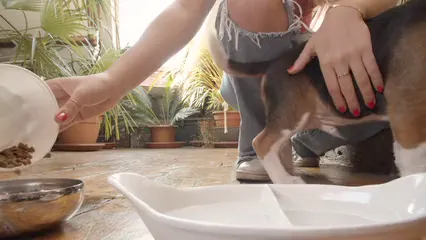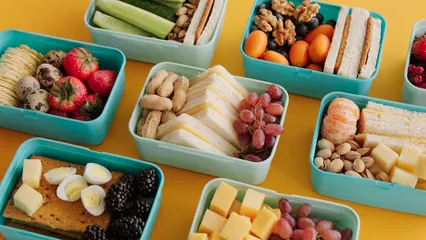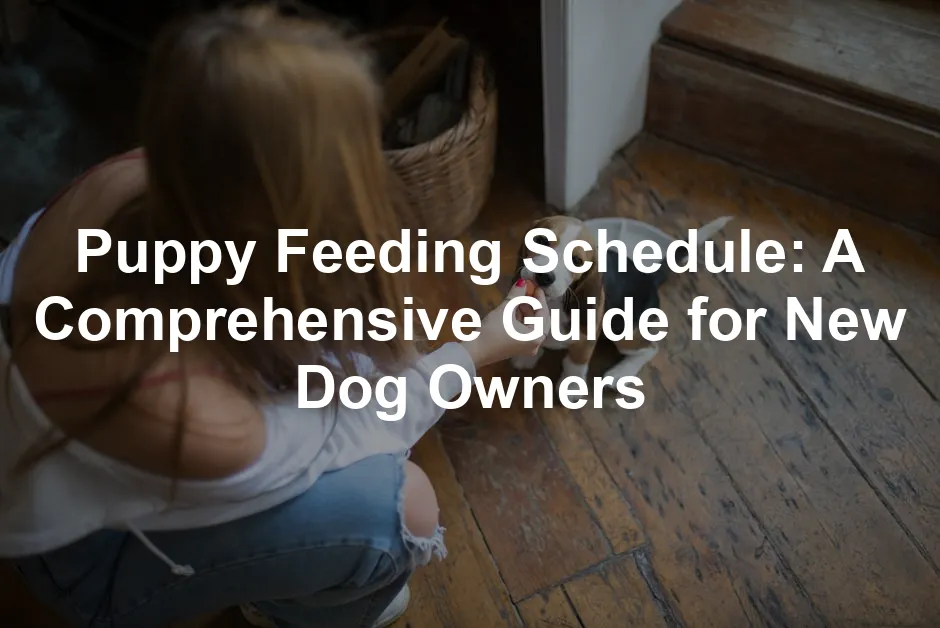Understanding Puppy Nutritional Needs
Nutritional Requirements by Age
Puppies grow rapidly, so their nutritional needs vary significantly by age. Younger puppies, especially those from weaning to three months, require higher amounts of protein and fat. Protein helps build muscles, while fat provides the necessary energy for their playful activities.
As puppies age, their dietary needs shift. From three to six months, you can gradually reduce protein and fat. Still, it’s vital to monitor their weight closely during this period. By six to twelve months, growth slows down. Adjust food portions and frequency as needed.
A balanced diet is key to supporting your puppy’s immune system and overall health. Essential vitamins and minerals also play a crucial role in their development. Always consult a veterinarian for personalized advice on your puppy’s nutrition. This ensures they receive the best diet tailored to their specific needs.

Speaking of nutrition, if you’re looking for a top-notch puppy food option, consider Hill’s Science Diet Puppy Chicken Meal & Barley Recipe. It’s formulated specifically for growing pups, ensuring they get the nutrients they need to thrive!
Creating a Puppy Feeding Schedule
Recommended Feeding Frequency
Feeding schedules for puppies depend on their age. For puppies under four months, four meals a day are ideal. This frequent feeding keeps their energy levels stable and supports their rapid growth.
As they reach four to six months, you can decrease feedings to three times daily. This adjustment aligns with their slower growth rate while still providing necessary nutrients.
Once your puppy turns six months old, two meals per day become sufficient. Regular meal times help regulate their metabolism and prevent overeating. Consistency is key; stick to a schedule to promote good habits.
Use a feeding chart based on your puppy’s age to plan meals effectively. This ensures they receive the right amounts at the right times.

To make clean-up easier, consider using AmazonBasics Dog Training Pads. They’re perfect for those little accidents and help keep your home clean while your puppy learns the ropes!
Ideal Meal Times
Establishing regular meal times for your puppy is essential. A consistent feeding schedule helps regulate their metabolism and supports healthy growth. Aim to feed your puppy in the morning and evening. This routine not only provides structure but also ensures they receive the nutrients they need throughout the day.
Avoid late-night meals, as they can disrupt your puppy’s digestion and sleep. Feeding them too close to bedtime may lead to accidents during the night. Instead, schedule the last meal a few hours before sleep. This allows for digestion and comfort.
Creating a daily schedule will help maintain consistency and set your puppy up for success in their feeding routine.

How Much to Feed Your Puppy
Portion Sizes by Weight
Determining how much to feed your puppy depends on their weight and age. Generally, puppies need about 5-6% of their estimated adult weight in food daily. As they grow, adjust their intake based on activity level and body condition.
Here’s a simple feeding chart to guide you:
| Weight Range | 1.5 – 3 months | 4 – 5 months | 6 – 8 months | 9 – 11 months | 1 – 2 years |
|---|---|---|---|---|---|
| 3-12 lb | ½ to 1 cup | ¾ to 1⅓ cups | ½ to 1½ cups | Feed as Adult | Feed as Adult |
| 13-20 lb | ½ to 1¼ cups | 1⅓ to 2 cups | ¾ to 1⅓ cups | ½ to 1½ cups | Feed as Adult |
| 21-50 lb | ½ to 1½ cups | 1½ to 2¾ cups | 1⅓ to 2⅓ cups | 2 to 3 cups | 2 to 4¼ cups |
| 51-75 lb | ⅓ to 2⅓ cups | 1½ to 4 cups | 1½ to 3⅔ cups | 2½ to 4⅔ cups | 2⅓ to 6⅓ cups |
| 76-100 lb | 1 to 2¾ cups | 2⅔ to 3¾ cups | 2⅔ to 6⅓ cups | 3 to 7 cups | 5⅓ to 11 cups |
| 101+ lb | 2¾ cups + ⅓ cup for each 10 lbs over 100 lbs | 3¾ cups + ⅓ cup for each 10 lbs over 100 lbs | 6⅓ cups + ⅓ cup for each 10 lbs over 100 lbs | 7 cups + ⅓ cup for each 10 lbs over 100 lbs | 11 cups + ⅓ cup for each 10 lbs over 100 lbs |
Keep in mind this chart is a guideline. Consult your veterinarian for personalized recommendations based on your puppy’s unique needs. Regularly measure and adjust portions as your puppy grows to ensure they remain healthy and active.

And while you’re keeping track of those portions, don’t forget about a reliable IRIS USA Airtight Pet Food Container to keep your pup’s food fresh and tasty!
Monitoring Growth and Adjusting Diet
Monitoring your puppy’s growth is crucial for their health. One effective method is body condition scoring. This simple system helps you assess whether your puppy is gaining weight appropriately. Ideally, your puppy should have a visible waist and ribs should be easily felt. If you notice excessive fat covering their ribs, it may indicate overfeeding. Conversely, if the ribs are prominent, your puppy might be underfed.
Frequent weigh-ins can help track their progress. Puppies should gain about 10-15% of their weight weekly in the early stages. If weight gain is inconsistent, adjust their food portions accordingly. Look for signs of overfeeding, such as a sluggish puppy or a rounded belly. Underfeeding signs include low energy and visible ribs.
Regular consultations with your veterinarian are essential for personalized guidance. They can assess your puppy’s growth and recommend dietary adjustments based on their specific needs. Weigh your puppy regularly and consult a vet for guidance.

Choosing the Right Puppy Food
Types of Puppy Food
When selecting food for your puppy, you have several options. Dry kibble is popular due to its convenience and long shelf life. It often contains balanced nutrition tailored for growth. Wet food can enhance palatability and hydration, making it a great choice for picky eaters.
Raw diets are gaining interest among some pet owners. They focus on natural ingredients mimicking a dog’s ancestral diet. However, these require careful handling to prevent bacterial contamination. Homemade options are also available, allowing you to control the ingredients. Ensure they meet nutritional standards to support your puppy’s development.
Choosing high-quality food is essential. Look for brands that prioritize complete nutrition and meet AAFCO standards. Consult with your veterinarian to select the right food for your puppy’s specific needs and ensure they receive optimal nutrition for healthy growth.

For a tasty and nutritious treat to complement their meals, try Blue Buffalo Wilderness Trail Treats. These treats are made with real meat and are grain-free, making them perfect for rewarding your furry friend!
Ingredients to Look For
Choosing the right puppy food is essential for their growth. When shopping, focus on high-quality ingredients that support their development. First, look for protein sources like chicken, beef, or fish. These are crucial for muscle growth. Your puppy needs plenty of protein to build strong bodies.
Next, healthy fats play a vital role too. Fats provide energy and help maintain a shiny coat. Look for sources like fish oil or flaxseed oil. These fats also contain omega-3 and omega-6 fatty acids, important for brain health.
Vitamins and minerals are just as important. Ensure the food contains essential nutrients like calcium, phosphorus, and vitamins A, D, and E. These support bone health, immune function, and overall development.
Always read labels carefully. Choose foods that meet AAFCO standards for complete and balanced nutrition. This ensures your puppy receives all the nutrients they need. Investing in high-quality puppy food now will pay off in their health later.

Transitioning from Puppy Food to Adult Dog Food
When to Make the Switch
Transitioning your puppy to adult food is an important step. The right timing depends on their breed size and growth rate. Generally, small breeds can switch around 12 months. Larger breeds may need to wait until they are 18-24 months old.
Watch for signs that indicate readiness. If your puppy reaches about 90% of their expected adult weight, it may be time to change their diet. Monitor their energy levels and overall health during this period.
Consult your vet for personalized advice on when to make the switch. They can help you determine the best time based on your puppy’s specific needs.

During this transition, consider keeping a close eye on their dental health with a Vet’s Best Enzymatic Dog Toothpaste. It’s a great way to ensure their teeth stay clean and healthy!
How to Transition Gradually
Transitioning from puppy food to adult food should be gradual. Sudden changes can upset your puppy’s digestive system. Start by mixing a small amount of adult food with their puppy food.
Begin with 25% adult food and 75% puppy food for the first few days. If your puppy adjusts well, gradually increase the adult food over the next week. Aim for a 50/50 mix, then 75% adult food by the end of the week.
Keep an eye on your puppy’s reaction during the transition. Look for any signs of digestive upset, like diarrhea or vomiting. If any issues arise, slow down the transition. Always consult your vet if you have concerns. This careful approach will help ensure a smooth switch to adult food.
For more detailed guidance on how to create a puppy feeding schedule, check out our dedicated post.
As you prepare for your puppy’s growth, don’t forget about their comfort! A cozy Furhaven Pet Dog Bed can make all the difference in ensuring they get their beauty sleep. After all, a well-rested puppy is a happy puppy!
Please let us know what you think about our content by leaving a comment down below!
Thank you for reading till here 🙂
All images from Pexels





